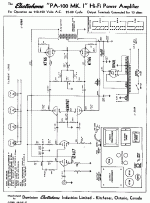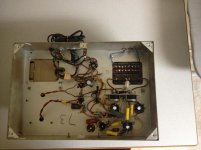I have a pair of kt66 monoblocs that have been repaired within the last year or so but I'm wondering if anyone knows any quality YouTube tutorials to help me with the diagnosis?
One of the amps has developed a noise issue that id like to repair. It's a relatively basic Williamson with about 6 caps and 20 resistors.
I'm retired so have lots of time, I did receive electronics training in the army 29 years ago so not gonna set myself on fire.... I hope lol
Looking for somebody to "show me the way"
One of the amps has developed a noise issue that id like to repair. It's a relatively basic Williamson with about 6 caps and 20 resistors.
I'm retired so have lots of time, I did receive electronics training in the army 29 years ago so not gonna set myself on fire.... I hope lol
Looking for somebody to "show me the way"
I have a pair of kt66 monoblocs that have been repaired within the last year or so but I'm wondering if anyone knows any quality YouTube tutorials to help me with the diagnosis?
One of the amps has developed a noise issue that id like to repair. It's a relatively basic Williamson with about 6 caps and 20 resistors.
I'm retired so have lots of time, I did receive electronics training in the army 29 years ago so not gonna set myself on fire.... I hope lol
Looking for somebody to "show me the way"
How about starting to give some photos with the used wiring?
Although the circuit is a "relatively basic Williamson with about 6 caps and 20 resistors.", a circuit
diagram is still of much use.
Hi bolly,
Start by rocking the various tubes slightly in their sockets. Don't try that with the outputs as they are octal. You might burn yourself or break the key base. You didn't specify what you are hearing, so I suggested the most common noise generator.
For probing components you want an insulated object to tap - push the components a tiny bit. This can help in locating intermittent faults. Don't use freeze spray as the condensation is conductive - assuming you have some collected dust and dirt in there. If the spray were to hit a tube that was hot ...
-Chris
Start by rocking the various tubes slightly in their sockets. Don't try that with the outputs as they are octal. You might burn yourself or break the key base. You didn't specify what you are hearing, so I suggested the most common noise generator.
For probing components you want an insulated object to tap - push the components a tiny bit. This can help in locating intermittent faults. Don't use freeze spray as the condensation is conductive - assuming you have some collected dust and dirt in there. If the spray were to hit a tube that was hot ...
-Chris
I can't help you with a youtube recommendation but "developed a noise" means something that was ok went bad. To narrow down what that could be you need to look at that "noise". Is it 120Hz hum? Or a hiss? Or a weird oscillation?
Also a systematic approach going from input stage towards output helps. First short the input of the amp. Is the noise still there? Move forward. In the Williams circuit as I know it the first two stages are dc coupled so don't ground the grid of the second stage.
Ground the grids of V3 and V4. Still noisy? Then it's probably the output tubes. You get the idea.
Also a systematic approach going from input stage towards output helps. First short the input of the amp. Is the noise still there? Move forward. In the Williams circuit as I know it the first two stages are dc coupled so don't ground the grid of the second stage.
Ground the grids of V3 and V4. Still noisy? Then it's probably the output tubes. You get the idea.
Have it hooked up to a spare grundig 7048 and I'm not sure it's as sensitive as my corals but tapping on all components reveals no change, slight wiggle of all tubes no change
figured I'd check bias and balance, I believe the bias is ok at .130a as it calls for .125 and .130 is as low as I can adjust it
What concerns me is the balance, supposed to be 0v and I measured over 2v so readjusted closest to 0v. I have NO flipping idea how that was so far off, would this be the cause of the noise?
figured I'd check bias and balance, I believe the bias is ok at .130a as it calls for .125 and .130 is as low as I can adjust it
What concerns me is the balance, supposed to be 0v and I measured over 2v so readjusted closest to 0v. I have NO flipping idea how that was so far off, would this be the cause of the noise?
Hi bolly,
You should be able to bias colder than that, but it is safe to run that way. The balance makes me want to look at the output tubes. They should be matched. Maybe one was running much hotter than the other?
The prime reason why the balance adjustment would be off is poor adjustment. A bad output tube would be the other popular cause. Measure your grid voltages and make sure you don't have a leaky capacitor connecting the driver tube to the grid of the output tube. A leaky capacitor would certainly cause all your problems, as would a bad output tube.
-Chris
You should be able to bias colder than that, but it is safe to run that way. The balance makes me want to look at the output tubes. They should be matched. Maybe one was running much hotter than the other?
The prime reason why the balance adjustment would be off is poor adjustment. A bad output tube would be the other popular cause. Measure your grid voltages and make sure you don't have a leaky capacitor connecting the driver tube to the grid of the output tube. A leaky capacitor would certainly cause all your problems, as would a bad output tube.
-Chris
bolly, are the filter capacitors still connected to the circuit??? If they are, stop using the amplifier immediately. The old caps must be disconnected, and it looks like cheap capacitors were used with the old terminals to support them. Who did the work?
I'm in Georgetown in case you need someone to look at that unit.
-Chris
I'm in Georgetown in case you need someone to look at that unit.
-Chris
Looking for somebody to "show me the way"
This looks reasonably good for starters, even though it's for musician type amps.
Tube Amplifier Debugging Page
Last edited:
An early stage of any fault finding should be checking DC voltages.
An even earlier stage should be making sure to survive the fault finding. Looks as if the unit has a two-wire mains connection with one of the leads directly connected to the chassis. Wouldn't want to power this one up without an insulation transformer.
Regards,
Rundmaus
dunno anatech, the balance being off really threw me for a loop, no idea how it got like that!! will research your advice and do some checking...
thanks for the link rayma, will read asap!
Rundmaus, every PA100 and PA100 Mk1 is wired the same, with the chassis ground. I've used these off and on maybe 10 years without much problem, whats the isolation txfmr for?
thanks DF96, will research your advice and make some measurements as well
thanks for the link rayma, will read asap!
Rundmaus, every PA100 and PA100 Mk1 is wired the same, with the chassis ground. I've used these off and on maybe 10 years without much problem, whats the isolation txfmr for?
thanks DF96, will research your advice and make some measurements as well
just had a look at the link rayma, it's a good start, thank you!
what I think I'm looking for is a way to inject a signal into the amp and using a scope follow it through each stage of the amp comparing each signal to the original... surely noisy sections or components should show up right away? but I really don't know how a tube amp works
what I think I'm looking for is a way to inject a signal into the amp and using a scope follow it through each stage of the amp comparing each signal to the original... surely noisy sections or components should show up right away? but I really don't know how a tube amp works
surely noisy sections or components should show up right away?
A simple thing to try is to lift one end of both of the two coupling capacitors to the output tubes.
This won't disturb the DC bias, but if the noise is in the circuit before that point, it should go away.
I expect that it will. Carefully insulate the free ends of both capacitors, of course.
Be sure to use "junk" speakers for this, unless you can easily see the noise on a scope instead.
Last edited:
Be sure to use "junk" speakers for this.
herein lies the problem, my corals are fairly high sensitivity and not sure the grundig 7048 or my Philips 3800m are high enough
right now I don't really hear the noise on either of them, it's only when I think the amp's working correctly and reconnect it to the coral that I hear the hissss and other erroneous noise (I'll perform the tube swap and see what happens first)
I'll need to find some junk highly sensitive speakers for testing purposes
- Status
- This old topic is closed. If you want to reopen this topic, contact a moderator using the "Report Post" button.
- Home
- Amplifiers
- Tubes / Valves
- Tube amp diagnosis fault finding for beginners?

